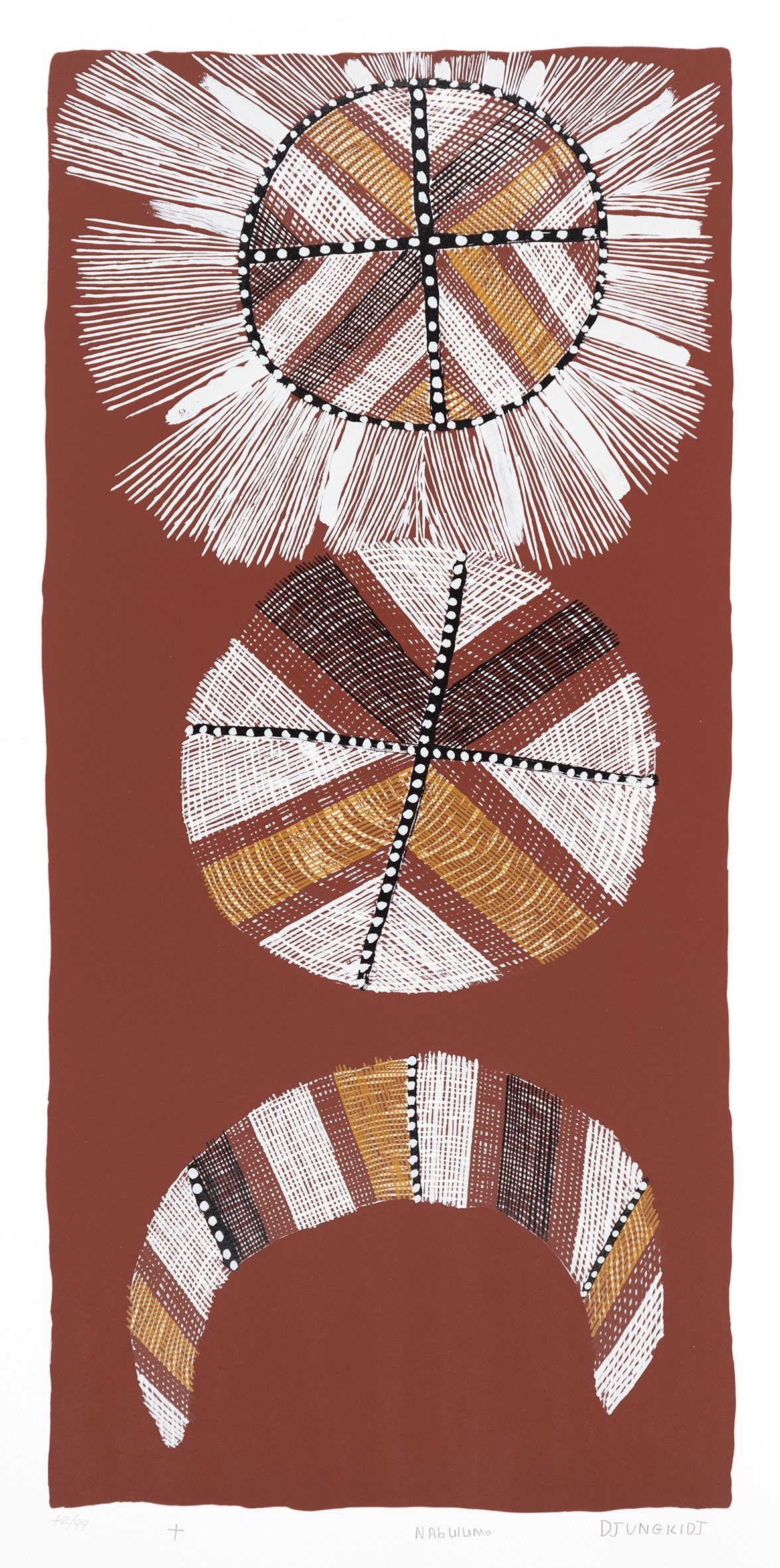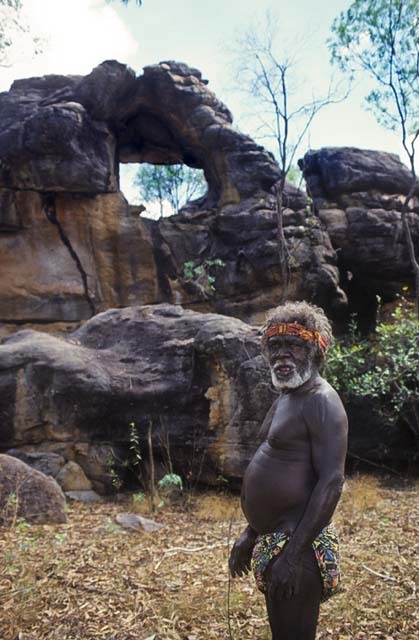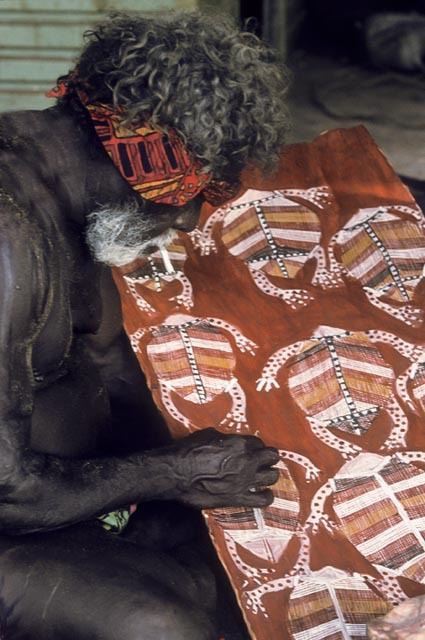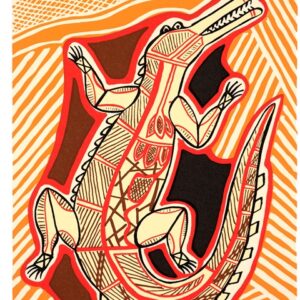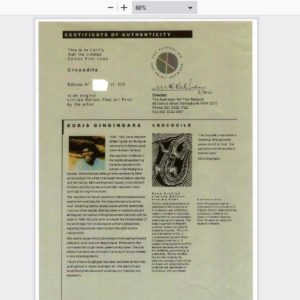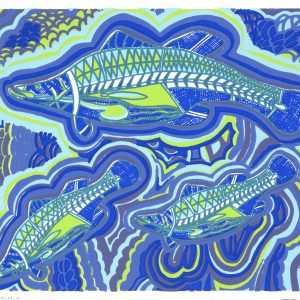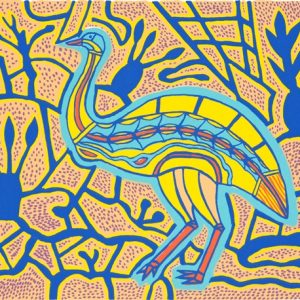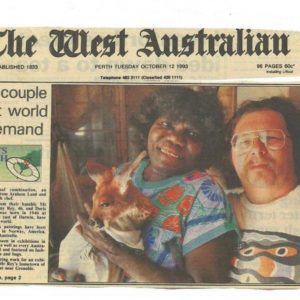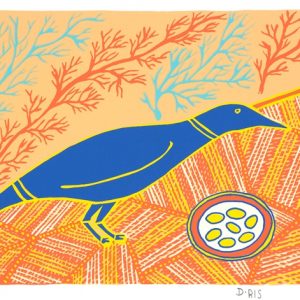Description
About the artwork:
Mick Kubarkku was renowned for his paintings of celestial objects; the full and new moons, the sun and stars. Here he has created an image of the full and new moon called, in the Eastern Kunwinjku language, dird bukkulurl and lirrk kurrmeng. In this image they are accompanied by the sun and its spiky rays, seen at the top of the print. The image refers to a site in the clan estate of Mick and his children, at a place called Dirdbim which literally means ‘image of the moon’. The site is a large unusually round hole in a sandstone residual on the plain not far from the Mann River. The large hole is said to be the full moon created by the rainbow serpent ‘ngalyod’ who pierced the rock in times of the ‘Dreaming’ and left the shape of the full moon. Dirdbim is not far from the artists’ residence today at Yikarrakkal and the area is rich in rock art and old camping sites. There are also numerous human remains, bones wrapped up in paperback, lying in clefts of sandstone shelters. The Eastern Kunwinjku people of the district have always used Dirdbim as a mortuary site because of the mythological history of the area which is connected to the moon story. This is because the mythology of the moon ancestor relates how an adversary, the spotted quoll, argued with the moon over the fate of humanity. The quoll decided he would die once and once only, however, the moon took his place in the sky to be reborn each lunar month. Because of this Kubarkku often painted this subject with bones or murrngno surrounding the image, just as the actual site at Dirdbim is surrounded by human bones. The techniques of bark painting are usually handed down from one generation to the next, as are the rights of each artist to a particular site or ‘Dreaming’.
The creation of this print by the master artist Mick Kubarkku was assisted by his two sons Ken Djungkidj and Paul Nabulumo and thus reflects the process of intergenerational knowledge transmission.
Details
- Limited edition screenprint on paper
- Edition: 99
- Editioned: August, 1999
- Size: 800 x 330 mm (image), 1000 x 515 mm (paper)
- Paper: Magnani 350 gms
- Printer & Studio: Helen Berry, Northern Editions Darwin, NT, March 2000
About the artists: Mick Kubarkku and sons
c1922-2008
Mick Kubarkku is recognised as being one of the great Kunwinjku/Kuninjku artists. He was born c.1922 at Kukabarnka, the large Marrinj clan wetland area near the Liverpool River of Western Arnhem Land. Having spent his youth largely oblivious to a European presence, he was one of the few who remembered the old men who painted the caves there, and could give detailed interpretations of their content. His father Ngindjalakku, instructed him in the creation of paintings for sacred ceremonies and he lived between his father’s Kulmarru land and his mother’s Kardbam country. As he matured through adolescence he attended and made art for the many Kunabibi, Wubarr and Mardayin ceremonies that were held there. It was not until the outbreak of the war that Kubarkku was rounded up with his brothers and sent to Milingimbi Mission. Kubarkku returned to his country at the end of the war, however, wanting tobacco, he decided to live at Oenpelli and work at the buffalo shooters camps.
Though he had sold a few barks at Oenpelli beforehand, Kubarkku moved to the new Government settlement of Maningrida in 1957 and along with David Milaybuma became the first of the regular painters there. A system of marketing art had operated since the 1950’s at Yirrkala and Millingimbi however it would be twelve years after Kubarkku began painting on bark before Maningrida Arts and Culture would be established in 1969.
In his early barks, Kubarkku restricted himself to the dotted infill reminiscent of rock paintings. However, later he incorporated his father’s ‘rarrk’ cross-hatching from the Mardayin ceremony into a rugged and individual painting style. Gowan Armstrong, Maningrida’s chaplain, recalled that ‘the ever cheerful Mick Gubargu (sic) began to bring his crocodile paintings from about 1970s onwards‘ (cited in Altman 2004: 176). These were accompanied by barks depicting other totemic animals including barramundi, turtle, kangaroo and echidna. The crosshatching that adorned these and other totemic figures at the time was not the meticulous geometric rarrk, common throughout Arnhem Land. It was less refined than that of many of his contemporaries, having a similarity in style to the rock markings found in the country near Kubumi, where he lived during the most artistically productive period of his life. His subject matter and stories were a direct continuation of that cave-art tradition executed with a raw, rough, and direct quality, in which the use of white dotted areas on black is a stylistic marker.
With thanks to Coo-ee Gallery, Sydney NSW. More detailed artist’s profile here.
Kubarkku’s artworks were included in a number of Australian and international exhibitions and accompanying publications catalogues from 1983 onwards. He was featured in the 1995 exhibition and catalogue: Rainbow, Sugarbag and Moon, Two Artists of the Stone Country: Bardayal Nadjamerrek and Mick Kubarkku, edited by Margie West and published by Museum and Art Gallery of the Northern Territory.
Provenance:
This edition was created in partnership with Maningrida Arts & Culture and commissioned by Anne Phelan and John Clark of Framed Gallery, the premier and groundbreaking fine art and craft gallery that operated in Darwin from 1984-2017. The artist was paid at the time of printing.
This artwork was distributed by the Australian Art Print Network.

